Abstract
This study conducted experiments and simulations to examine the DC corona-generated space charge characteristics and understand the performance of high-voltage direct current (HVDC) transmission lines. In experimental studies, various gradient temperatures are tested on a standard model of the potential HVDC transmission line in Southern Africa using an indoor corona cage. Initial tests on the single-line model of aluminium TERN conductors measured the DC corona inception voltages (CIVs) as the ambient temperature increased from 25 °C to 42 °C. A daylight ultraviolet corona camera (CoroCam8) has been used for measurements and visualisation; the measurements record temperatures for positive and negative direct current (DC) voltages. Experimental investigations are supplemented by simulations utilising the finite element method (FEM)-based software COMSOL Multiphysics. Following the creation of 3D models of the corona cage and potential conductor arrangement, the electric field distribution on the surfaces of the conductors was examined. The CIV observations and modelling findings determine the setups’ corona inception electric field strengths. The study effectively integrated experimental data from a corona cage with FEM models to assess DC corona properties across different air temperatures thoroughly. The inception voltage levels of corona are significantly influenced by ambient temperature and the space charge generated by corona. The outcomes of the discussion will inform the design of the proposed HVDC transmission line in Southern Africa.
1. Introduction
High-voltage direct current (HVDC) transmission has grown in demand as the amount of electricity transmitted over long distances has increased significantly. As a result, numerous HVDC transmission lines have been constructed globally [1,2]. HVDC transmission technology offers technical, financial, and environmental advantages over the standard AC grid when transmitting bulk electrical energy over long distances or asynchronous interconnections [3,4]. The need to expand transmission capacity has grown with the steady increase in power demand. Governments face numerous challenges in meeting the increasing demand for electricity due to constraints, such as voltage range, conductor limitations, high costs, and limited land availability for transmission line tower design. Even though HVDC has many benefits, such as fewer stability problems, no synchronisation concerns, lower prices, etc., there always needs to be adequate backing for the new power lines. In addition to its well-known advantages, HVDC systems exhibit greater corona performance than conventional AC transmission. HVDC transmission is anticipated to be increasingly significant in future power systems, introducing novel issues for electrical engineers. A self-sustained corona discharge transpires in the atmospheric vicinity of a conductor when the voltage gradient on its surface exceeds a defined threshold. Corona discharge is affected by environmental factors, including humidity and temperature, as well as the nature of the voltage, conductor material, conductor diameter, and surface roughness [3]. The corona properties of transmission lines considerably influence their design and affect line performance [5,6]. Corona-induced space charge, corona inception voltages (CIVs), and corona losses (CL) are among the most significant aspects to consider in the design of transmission systems. The conductor size and ambient conditions influence these parameters [7].
Computational models are essential for analysing and forecasting the corona effects in HVDC lines linked to HVAC systems. These models are especially beneficial for examining the intricate interplay between AC and DC fields and their influence on space charge properties. Simulations based on the finite element method (FEM) are extensively employed to study electric field distribution and space charge dynamics in corona cages. Experimental data validate these simulations to ensure precision [8,9]. The time-domain finite element method is utilised to analyse transient overvoltages and their impact on corona discharge. It offers insights into the dynamic behaviour of space charges under different electric field situations [10]. The hybrid simulation technique integrates the finite element technique (FEM) and finite volume methods to simulate ion flow fields and corona currents in hybrid AC-DC systems. These techniques effectively examine corona losses and ion current distributions [11,12]. Corona characteristics may be computed using empirical formulas and simulations of the field distribution [13,14] or may be discovered through experimental research. Calculations based on simulations might produce erroneous conclusions due to the complexity of the corona phenomenon. Conversely, experimental research employing single-phase overhead test lines is constrained by their high costs and insufficient laboratory space [15]. To effectively assess the corona properties of the surface’s transmission line, using corona cages and testing under varying temperature conditions is recommended due to their efficiency, speed, and cost-effectiveness [16]. To replicate the operational environment accurately, the cage’s dimensions and the conductors’ lengths must be adequate. For the specified voltage level and conductor geometry, it is recommended that the cage be designed utilising simulations.
The determination of CIV has been extensively investigated through various experimental and numerical studies documented in the literature. The assessment of corona losses, electric field strengths, and current density profiles associated with single monopolar HVDC transmission lines was detailed in references [17,18], utilising a FEM-based methodology; nevertheless, the influence of temperature on these phenomena is not well-defined in the existing literature. Semi-empirical formulations were developed for fair and hot weather conditions to calculate corona losses in monopolar HVDC lines by interpolating experimental data [19]. However, the reliability and stability of HVDC transmissions depend on a clear understanding of the physical interactions between the transmission environment and the electrical infrastructure. One of the most critical phenomena affecting HVDC performance is the corona discharge, which forms space charges in the surrounding air around the transmission conductors. These space charges modify the electric field distribution, potentially leading to conductor stress, partial discharges, and long-term material degradation.
Atmospheric temperature plays a crucial role in this process [20,21]; it influences the corona onset voltage by affecting air density, ion mobility, and space charge drift within and around the HVDC line conductors [22,23]. Understanding these temperature-related effects is crucial for optimising HVDC line design, enhancing system reliability, and minimising environmental impacts, such as corona inception voltage, radio noise, and audible sound [24,25].
2. Experimental Setup
2.1. Corona Cage 3D Design
The experimental laboratories began with software design, where the real corona cage was first designed and tested before its construction. Several corona cage designs have been developed, and the final design is presented in Figure 1 below. A laboratory corona cage serves as an instrument for assessing the corona performance of conductors. It consists of a concentric metal cage with a substantial radius, available in either a circular or square cross-section. It incorporates a test line at its centre to replicate a single or multiple (bundle) conductor(s). It was decided to design a cage with a diameter of 1.5 m, which will be housed at the Vaal University of Technology’s HV Laboratory. This diameter would ensure that corona studies can be carried out without fearing flashovers.
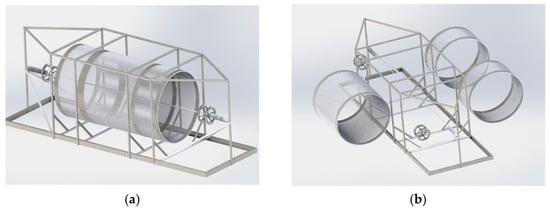
Figure 1.
(a) Three-segment cage, (b) final cage structure designed.
The cage’s structure is divided into the following three distinct sections: two outer guard rings, each measuring 0.5 m long, and one central measuring section, which is 1 m long. A support structure was built to support the cage and be meshed for a proper simulation, as shown in Figure 1b.
A corona cage is a single-phase testing facility, where conductors or conductor bundles are positioned centrally within a grounded mesh cage. The primary purpose of the corona cage configurations and dimensions is to accurately replicate the electric field distribution in the specified region surrounding the conductor through a small-scale measurement setup [26].
A corona cage is an ideal tool for studying the corona-generated space charge performance of transmission lines and conductors in a laboratory setup. Its practicability has been confirmed by [9,17,18,19,20,26,27,28], which presents several advantages; for example, it reduces the test space, as shown in Figure 2, has low investment, controllable test conditions, a convenient structure for adjustment, and a short test period compared to other test methods mentioned below.

Figure 2.
Virtual experimental setup in HV Laboratory.
Many studies have been conducted on the circular corona cage, which consists of the following three parts: a middle part for measurement and two sides for protection. Different corona cages have been employed for the corona test studies, as follows: the small or indoor corona cage [17,18], the outdoor or larger corona cage, the mobile corona cage, and the outdoor test line technique [9,19,20,26,27,28,29]. Although the test line remains the most efficient, its results approach the characteristics of practical transmission lines; this approach is very costly and hazardous.
CIV is the lowest voltage at which the continuous corona of specified pulse amplitude occurs as the applied voltage gradually increases. The CIV decreases as the frequency of the applied voltage increases. Under HVDC conditions, the inception voltage for negative corona on conductors is observed to be lower than that of the positive case, generally approximating 90% of the positive corona inception voltage [30,31].
2.2. Real Experimental Arrangement in the HV Laboratory
An indoor corona cage, measuring 387 cm in length and 150 cm in diameter, was used in the experiments. It was designed for corona discharge measurements and features a cylindrical shape, consisting of two shield segments at both ends and a measuring segment in the middle that can be electrically connected. The shield segments are designed to be electrically isolated from the measuring segment(s) to facilitate the measurement of corona discharge occurring on the conductor surface, while simultaneously preventing corona discharge on the cage. Figure 3 presents the comprehensive setup schematic diagram of the corona cage.
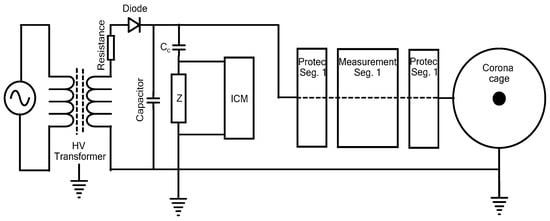
Figure 3.
The system configuration.
The HVDC supply utilised in the experiments consists of several components, including a transformer, diodes, damping and limiting resistors, and doubling and smoothing capacitors capable of delivering a voltage of up to ±270 kV. The shield segments are electrically isolated from the measuring segment to facilitate the measurement of corona generated on the conductor surface and to prevent corona discharge on the cage [30].
2.3. Corona Inception Voltage at the Ambient Temperature (CIV)
The corona inception voltage represents the minimum voltage level at which continuous corona discharge of a specified pulse amplitude occurs as the applied voltage gradually increases. The inception voltage of corona is inversely related to the frequency of the applied voltage, exhibiting a decrease as the frequency increases. In HVDC conditions, the positive corona inception voltage for conductors is higher than the negative case and is typically about 10% higher than the negative CIV [13]. In the operation of a practical power system, aluminium conductor steel reinforced (ACSR), referred to by the code word “TERN”, is commonly utilised instead of cylinder conductors for power transmission lines. The ACSR stranded conductors exhibit favourable electrical conductivity, sufficient mechanical strength, and tensile strength [7,8], the primary reasons for their use during the evaluation tests. Given the corona cage diameter and the conductor diameter, it is possible to estimate the CIV. This is often carried out using Peek’s empirical constants (E0 and K) in the well-known formula from the experimental data for the corona inception gradient Ec in kV/cm [15] in Equation (1) below for a smooth cylindrical conductor in air.
where:
E0: disruptive critical electric field of air ≈ 30 kV/cm (rms)
r0: conductor radius (in cm)
δ0: relative air density factor, resulting from:
where:
T: ambient temperature in °C
P: atmospheric pressure in mmHg
The inception voltage for negative corona for the HVDC conditions has been simplified using Peek’s empirical constants (E0 and K) with their average value [15].
For a conductor radius of 1 cm at 25 and 760 mmHg pressure, as an example:
δ is given by Equation (4) below, namely:
Figure 4 and Figure 5 show the CIV visualisation via the ICM monitor, which displays the number of charges at the first corona discharge for the positive and negative voltages.
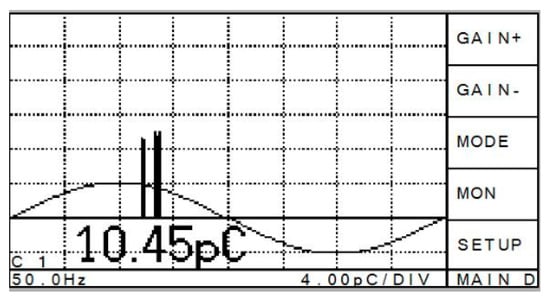
Figure 4.
Positive inception voltage at 21 kV.

Figure 5.
Negative inception voltage at −17 kV.
2.4. Environmental Temperature on the Corona Inception Voltage (Vinc)
The relationship between the corona inception voltage and temperature of the “TERN” conductor under the corona cage is summarised in Table 1.

Table 1.
Temperature data summary.
Figure 6 and Figure 7 below show the variation Vinc = f(T °C) function. Inception voltages range from −16 kV to −18 kV for negative voltage and +19 kV to +21 kV for positive voltage at temperatures between 25 °C and 42 °C, which correspond to the average ambient and maximum temperatures. It can be observed that the inception voltage decreases in both cases. This is mathematically true due to the presence of negative numbers. Still, it is not physically accurate, because the electric field is the cause of corona [9,27], and it is evident that the negative inception field decreases with increasing temperature.
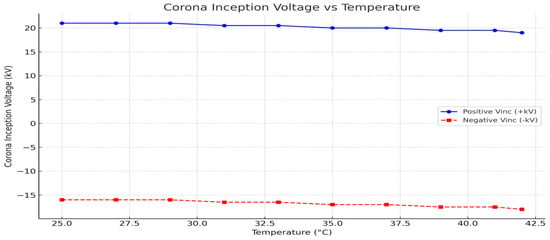
Figure 6.
Relationship between corona inception and temperature for positive and negative voltage.
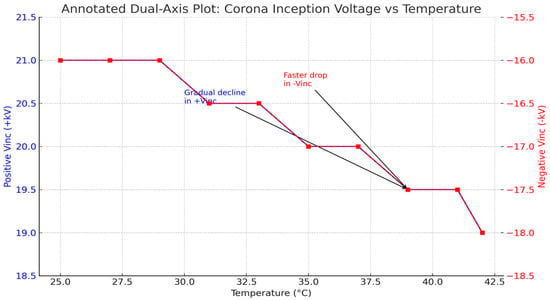
Figure 7.
Annotated dual-axis plot showing the temperature-dependent behaviour of positive and negative corona inception voltages in an HVDC system.
Figure 7 illustrates how corona inception voltage varies with temperature for positive and negative HVDC polarities. A gradual decline is observed in the positive inception voltage as the temperature increases, indicating reduced air dielectric strength. In contrast, the negative inception voltage drops more steeply, suggesting greater sensitivity of negative corona discharge to thermal effects. This polarity-dependent behaviour highlights the role of space charge dynamics and ion mobility under varying atmospheric conditions.
2.5. Experimental Procedure in the High-Voltage Laboratory
Figure 8 illustrates the corona cage in the high-voltage laboratory at the Vaal University of Technology. The general indoor corona cage comprises the following three components: an inner section designated for measurement and two outer sections known as protective guards [20]. The two outer sections are identical and intended for electrical connection.
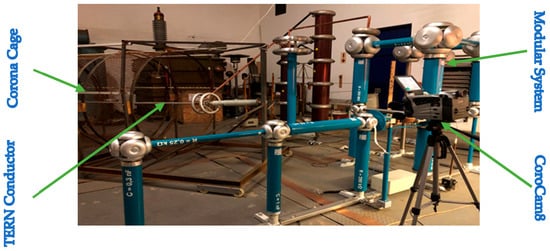
Figure 8.
Test setup photograph with corocam8.
The conductor (TERN), the most used conductor in the transmission line, was placed along the axis of the corona cage and stretched via post insulators. The guard electrodes of the cage were connected to the ground, along with the measurement segment. Thick conductors and corona rings were implemented at the connection points to mitigate undesired discharges. A test voltage was applied to one side of the test conductors, with the voltage gradually increasing from the inception voltage to 175 kV. A corona ring was used to terminate the other side. The test arrangement photo is shown in Figure 9, featuring the two giant heaters that gradually increased the room temperature, with the voltage capped at its highest and lowest values at ±175 kV for both positive and negative voltages.
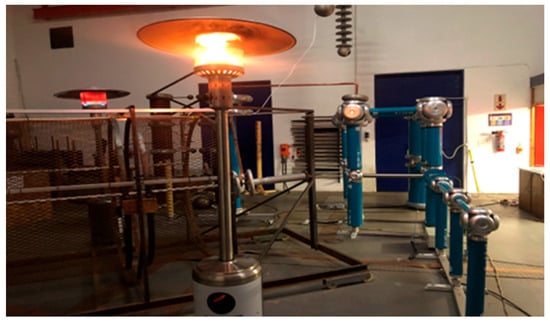
Figure 9.
The corona cage with the heater on in the laboratory.
2.5.1. Effect of Temperature on Corona-Generated Space Charge for a Positive Voltage
The process of heating and monitoring the room was accomplished using two giant heaters, each with a capacity of 3 kW, and coupled parallelly with the thermos-anemometer environment meter tester model (MT948), which can measure air flow, temperature, and air velocity, and a digital temperature humidity meter with a measuring range of −10 to 50 °C for the environmental temperature for more accuracy. These heaters, the thermos-anemometer environment meter tester and the Fluke T3000 FC wireless digital thermometer, were used to gradually increase and monitor the room temperature, allowing it to rise from its normal ambient temperature of 25 °C to 42 °C. A professional UV camera, the CoroCam8, manufactured by UViRCO Technologies, has been primarily used. Based on an indicator count parameter, we have observed the temperature’s impact on the corona cage’s transmission line conductor. The indicator count is a numerical value generated by the ultraviolet (UV) sensor in the CoroCam8 to quantify the intensity of corona discharge. It measures UV photon hits from corona activity on energised equipment surfaces, particularly those above a threshold of around 240–280 nm UV wavelength, corresponding to ionisation events in air. Currently, no globally fixed IEC or IEEE standard defines a universal “acceptable” indicator count threshold for the CoroCam8. Several organisations (e.g., CIGRÉ, EPRI) are working toward setting guidelines for corona visual inspection and quantification.
Upon completion of the experiment setup, the voltage was elevated to +175 kV (positive), concurrently with a gradual increase in room temperature to 42 °C. The CoroCam8 is positioned 150 cm from the corona source. Figure 10, Figure 11, Figure 12, Figure 13, Figure 14 and Figure 15 illustrate the spatial distribution at a constant voltage across varying temperatures. The top left corner indicates the energy loss during the experiment, known as the indicator count, along with the gain from the CoroCam8. A greater numerical value corresponds to increased losses.

Figure 10.
Positive voltage +175 kV at 25 °C.
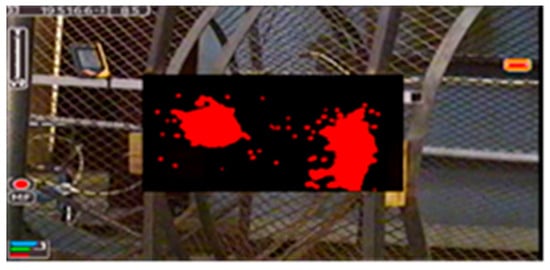
Figure 11.
Positive voltage +175 kV at 30 °C.
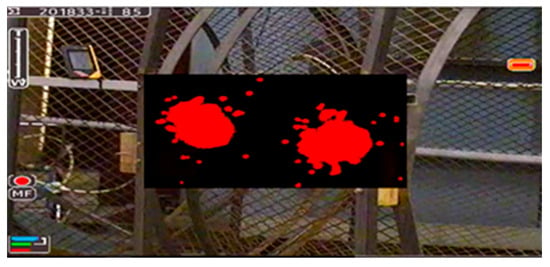
Figure 12.
Positive voltage +175 kV at 35 °C.

Figure 13.
Positive voltage +175 kV at 40 °C.

Figure 14.
Positive voltage +175 kV at 42 °C.

Figure 15.
Breakdown at +175 kV after 42 °C.
2.5.2. Effect of Temperature on Corona-Generated Space Charge for a Negative Voltage
The supply voltage has been maintained at −175 kV. At the same time, the temperature has been slowly increased from an ambient temperature of 25 °C to 42 °C, without changing the setup’s settings—the camera gains and the distance of the corocam8 from the source in the cage. The sole variable parameter, temperature, has been adjusted. Figure 16, Figure 17, Figure 18 and Figure 19 depict the spatial distribution across a temperature range of 25 °C to 42 °C.
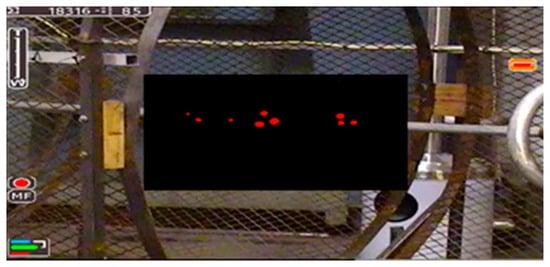
Figure 16.
Negative voltage −175 kV at 25 °C.
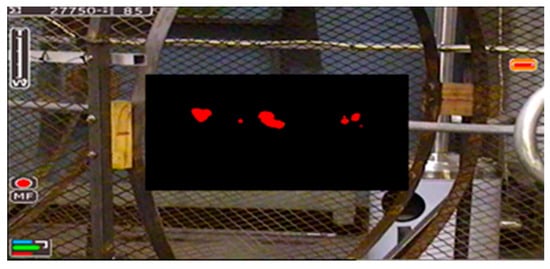
Figure 17.
Negative voltage −175 kV at 30 °C.
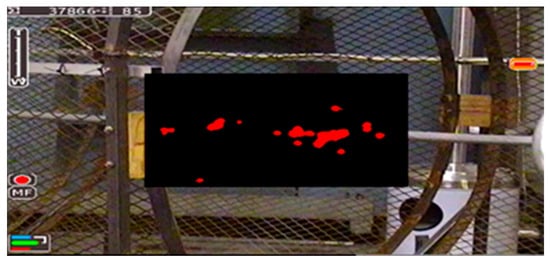
Figure 18.
Negative voltage −175 kV at 35 °C.

Figure 19.
Negative voltage −175 kV at 42 °C.
2.6. Effect of Temperature on Corona Loss for a Positive and Negative Voltage
Table 2 below summarises the variation in temperature and the indicator count recorded from the corocam8. It is important to note that the unit reflects the amount of energy (corona) loss during the experiment at a specific supply voltage.

Table 2.
Summary indicator count vs. temperature.
Figure 20 illustrates the variation in corona activity, measured by UV-based indicator counts from the CoroCam8 camera, as a function of ambient temperature under positive and negative HVDC voltage conditions. Under positive polarity, the indicator count increases nonlinearly with temperature, peaking around 40 °C before sharply declining at 45 °C, suggesting a possible thermal ion recombination or space charge saturation effect (breakdown). In contrast, the negative voltage condition exhibits a linear and moderate increase, reflecting a more stable space charge behaviour [32,33]. These trends highlight the polarity-dependent nature of corona discharge and suggest that atmospheric temperature plays a significant role in modulating ionisation intensity and spatial charge accumulation in HVDC environments.
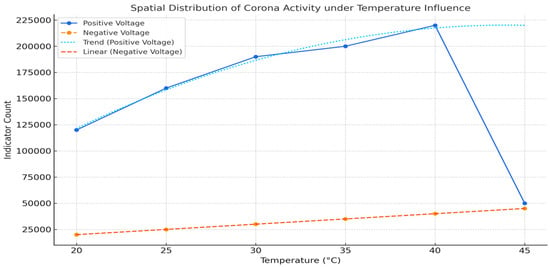
Figure 20.
DC corona loss under the influence of temperature.
3. Simulation Studies
Following the experimental study, the corona-generated space charge, directly associated with the distribution of the electrical field, was derived utilising a three-dimensional model of the electrode system. The 3D model features a meshing structure including a corona cage, conductors, and rings. All elements were modelled using their precise dimensions. Figure 21 illustrates a sample model of TERN configuration. COMSOL Multiphysics 5.5 software, which is based on the finite element method, is utilised for stationary applications. Meshing is the process of dividing a complex geometry or domain into numerous, more minor, simpler pieces (finite elements) that the software can use to solve the governing equations numerically. In COMSOL Multiphysics, creating a mesh is required after building the geometry. Before running the solver, it discretises the continuous model so that COMSOL can perform a finite element analysis. The purpose of meshing is to enable the finite element method to approximate the solution on each tiny element, as the solver cannot directly apply the equations to an arbitrary, complex shape in its continuous form. A good mesh will accurately represent the geometry and provide the necessary resolution for the simulated physics. Mesh is foundational to the simulation, as it significantly influences the accuracy of the results, the convergence of the solution, and the computation time. In short, meshing bridges the gap between the CAD geometry and the numerical solver, enabling COMSOL to compute an approximate solution to physics problems in real-world geometries.
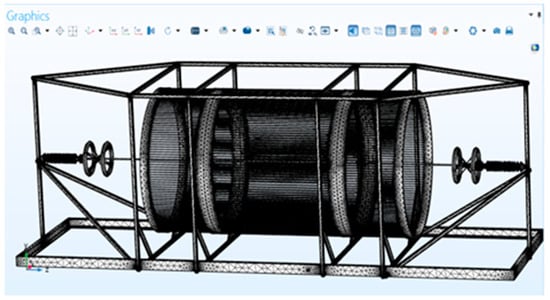
Figure 21.
Meshed 3D model of the corona cage and the TERN conductor configuration.
3.1. Simulation of the Effect of Temperature on Corona-Generated Space Charge for a +V Voltage
3.1.1. Mesh Quality Evaluation
Mesh quality was assessed using COMSOL’s built-in quality metrics, including aspect ratio, skewness, and element growth rate. Particular attention was paid to regions with high electric field gradients, such as near the conductor surface and ground plane, where finer meshing was applied using boundary layer refinement. The minimum element quality was maintained above 0.65 to prevent numerical instability.
3.1.2. Mesh Parameters Used
A physics-controlled mesh with user-defined element size control was applied. The conductor–air interface was discretised with a fine mesh (maximum element size: 0.005 m), while coarser elements (up to 0.05 m) were used in the outer air domain. The total mesh consisted of approximately 350,000 tetrahedral elements.
3.1.3. Mesh Convergence Test
Mesh convergence testing was performed by refining the mesh incrementally and comparing the resulting electric field magnitude at key points (e.g., conductor midpoint, corona ring tip). Convergence was confirmed when further refinement (<5% change in element size) resulted in less than 1% variation in the electric field values. The selected mesh density was, thus, validated for both accuracy and computational efficiency.
The simulation analysed temperature variation from 25 °C to 42 °C (hot atmosphere) impacts the corona discharge and electric field distribution around an HVDC transmission conductor carrying ±175 kV. The entire simulation procedure is summarised in the step-by-step setup with values, as follows:
- Step 1: Start a New COMSOL Project
- Choose Space Dimension: 3D. Next, select Physics Interfaces.
- Step 2: Add Physics:
- AC/DC Module > Electrostatics (for electric field distribution).
- Plasma Module > Corona Discharge (to simulate corona discharge and space charge).
- Heat Transfer Module > Heat Transfer in Fluids (to model temperature variation).
- Step 3: Define the Geometry
- HVDC Transmission Line Conductor Geometry:
- ▪
- Create a cylinder to represent the HVDC conductor.
- ▪
- Radius = 2 cm (0.02 m).
- ▪
- Length = 2 m (arbitrary, choose the length to simulate a section of the line).
- Air Domain:
- ▪
- Create a larger cylinder representing the air surrounding the HVDC conductor line.
- Radius = 0.75 m (to capture the influence of the electric field over a reasonable distance), the size of the cage.
- Height = 2 m (same as the conductor length).
- ▪
- Ground Plane:
- -
- Add a flat plane below the conductor (at 75 cm) to simulate the ground.
- Step 4: Define Materials
- Conductor: Assign aluminium to the HVDC line (from the Material Library).
- Relative permittivity (dielectric constant) = 1 (for metals).
- Conductivity = 5.8 × 1075.8\times 10^75.8 × 107 S/m.
- ▪
- Air Domain: Assign air to the surrounding volume.
- Relative permittivity = 1 (for air).
- Electrical conductivity: Use default air properties.
- Step 5: Setup Electrostatics (AC/DC Module)
- Voltage Potential:
- ▪
- Select the conductor surface and set the electric potential to ±175 kV.
- ▪
- Boundary condition: 200 kV DC (±200,000 V).
- Ground Potential:
- Set the ground plane (bottom of the air domain) to 0 V (ground potential).
- ▪
- Boundary Conditions:
- Leave the rest of the air domain as open boundary conditions, allowing the field to decay naturally in space.
- Step 6: Setup Corona Discharge (Plasma Module)
- Activate Corona Discharge:
- Apply the Corona Discharge interface to the air domain.
- ▪
- Corona Discharge Settings:
- Corona inception voltage: Set the threshold voltage for corona discharge to 200 kV (typical value for air breakdown).
- ▪
- Positive and Negative Ions:
- For the ion species, define:
- ▪
- Positive ion mobility = 1.5 × 10 − 41.5 \times 10{−4}1.5 × 10−4 m2/Vs (for typical ions in air).
- ▪
- Negative ion mobility = 2.0 × 10 − 42.0\times 10{−4}2.0 × 10−4 m2/Vs.
- Space Charge Accumulation:
- ▪
- Add positive and negative ion densities to simulate charge build-up.
- -
- Initial space charge density: 0 C/m3 (assume no initial charge).
- Step 7: Setup Heat Transfer (Heat Transfer Module)
- Heat Transfer in Air:
- ▪
- Apply the Heat Transfer in the Fluids interface to the air domain.
- Initial Temperature:
- ▪
- Set the initial air temperature to 25 °C, standard or ambient temperature
- Variable Temperature:
- ▪
- In the parametric sweep (Step 10), we varied the temperature between 25 °C and 42 °C.
- Air Properties:
- ▪
- Air properties, such as thermal conductivity, density, and specific heat, should be taken from COMSOL’s air material properties. These are already temperature-dependent in COMSOL.
- Step 8: Multiphysics Coupling
- Electrostatics and Corona Discharge:
- ▪
- Couple the Electrostatics with the Corona Discharge module to ensure that the corona-generated space charges affect the electric field distribution.
- Heat Transfer and Corona Discharge:
- ▪
- Couple Heat Transfer and Corona Discharge, so that the air’s ion mobility is affected by temperature, where mobility increases.
- Step 9: Mesh Generation
- Mesh Settings:
- ▪
- Use a fine mesh near the conductor to accurately capture the electric field and corona-generated space charge effects.
- ▪
- A coarse mesh can be used for the outer parts of the air domain to save computation time.
- Step 10: Study Setup
- Study Type: Select Stationary Study (for a steady-state solution).
- Parametric Sweep:
- ▪
- Define a parametric sweep for 25 °C and 42 °C atmospheric temperatures.
- -
- Parametric values: 25 °C, 30 °C, 35 °C, and 42 °C.
- Compute: Run the simulation.
After a proper setup and adjustment of the cage geometry and all other settings, the simulation was run for every specific temperature, with the voltages maintained at ±175 kV. The display of the corona generated around the conductor is shown in Figure 22, Figure 23, Figure 24, Figure 25, Figure 26, Figure 27, Figure 28 and Figure 29 below.
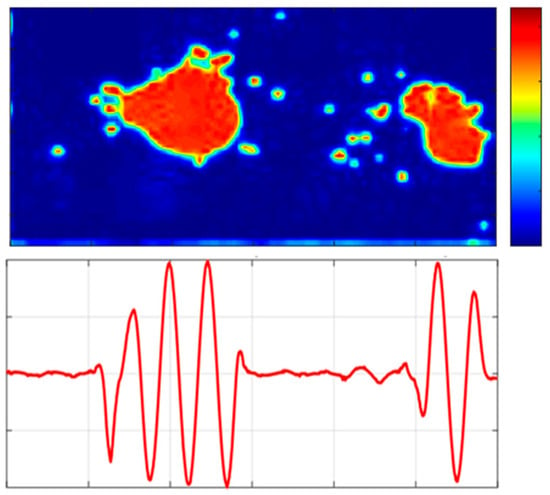
Figure 22.
Positive voltage +175 kV at 25 °C.

Figure 23.
Positive voltage +175 kV at 30 °C.
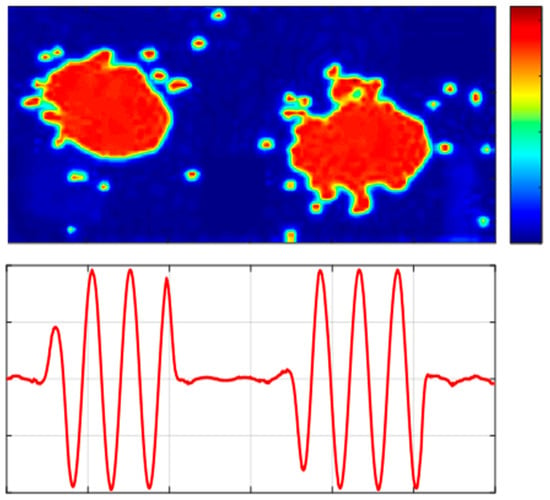
Figure 24.
Positive voltage +175 kV at 35 °C.

Figure 25.
Breakdown stage +175 kV after 42 °C.
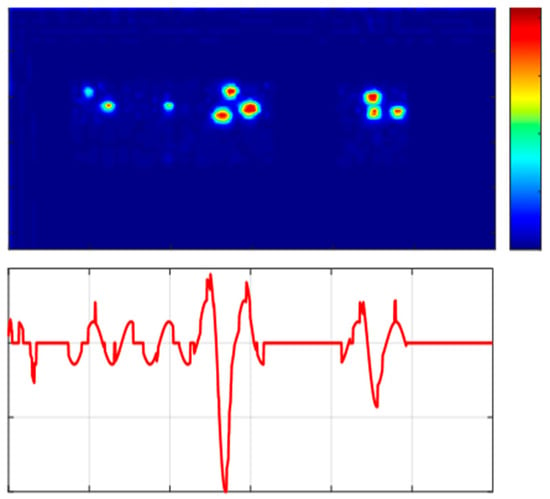
Figure 26.
Negative voltage −175 kV at 25 °C.
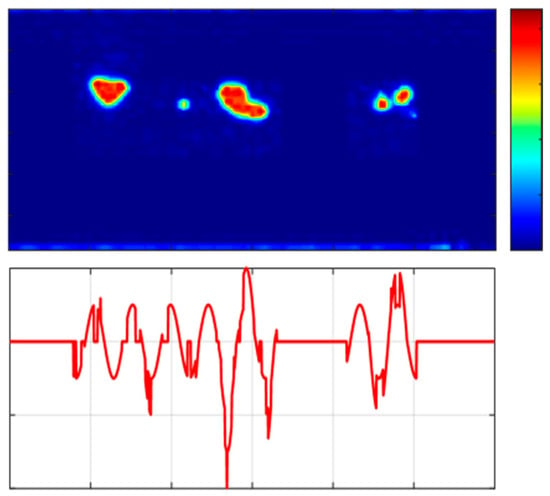
Figure 27.
Negative voltage −175 kV at 30 °C.
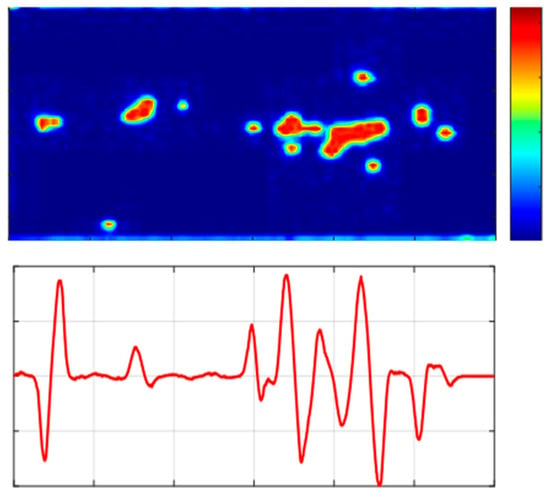
Figure 28.
Negative voltage −175 kV at 35 °C.
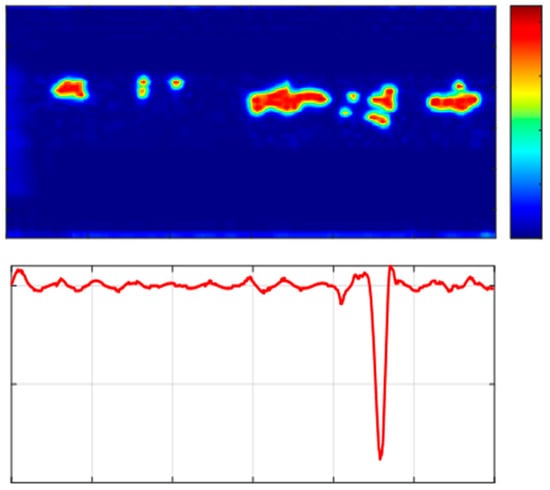
Figure 29.
Negative voltage −175 kV at 42 °C.
3.2. Simulation of the Effect of Temperature on Corona-Generated Space Charge for a −V Voltage
3.3. Validation Strategy: Simulation vs. Experimental Results
The electric field and space charge distributions were validated through comparison with experimental data collected in the indoor corona cage setup, as follows:
3.3.1. Electric Field Validation
Electric field probes were simulated at the same spatial points where field sensors or CoroCam8 camera readings were focused.
The electric field magnitude at the conductor surface and cage midplane was compared to inferred field values from corona onset voltages.
3.3.2. Space Charge Validation
Indicators count values from the CoroCam8 camera were used to proxy ionisation intensity. Simulated space charge densities (in C/m3) were mapped spatially and correlated with camera-detected hotspots. Regions of high simulated space charge concentration overlapped with areas of elevated UV emission in the CoroCam8 recordings, confirming spatial consistency.
3.3.3. Quantitative Alignment
Voltage thresholds at which corona first appeared in the experiment (e.g., +21 kV and 16 kV) were matched in simulation by adjusting the temperature, air density, and electric field strength until corona onset (i.e., ionization) occurred in the model. Good agreement (within 5–10%) was achieved in electric field values and indicator count trends, particularly at temperatures in the range of 25–39 °C.
3.4. Simulation Limitations (Thermal Modelling)
Below are the limitations in the FEM simulations related to thermal effects:
- The FEM simulations assumed uniform temperature fields, which may not reflect localised thermal gradients within the corona cage.
- The thermal coupling between the ionized air and surrounding surfaces was simplified, omitting transient or convective effects.
- Humidity was excluded as a parameter, though it is known to influence breakdown strength and charge mobility.
- The lack of direct space charge measurement tools means validation depends on indirect indicators (e.g., UV count, electric field).
4. Conclusions
This article analyses DC corona characteristics for a specific conductor, called the “TERN” conductor, utilising both experimental and simulation methods. An HVDC system was initially modelled using a corona cage with a scaled conductor. A cylindrical indoor corona cage measuring 270 cm in length and 150 cm in diameter was utilised for this purpose. After the initial assessments conducted with the single-line configurations, measurements were obtained using a daylight UV corona camera. During the second phase of the study, simulations based on the finite element method (FEM) were conducted utilising COMSOL Multiphysics software to ascertain the electric field distributions for the specified conductor across various atmospheric temperatures.
Simulations and test results were utilised alongside empirical formulas to assess the characteristics of the remaining corona-generated space charge. The test results are subsequently compared and analysed. The experimental results align with the findings from simulation studies. The corona test results were obtained by measuring the inception voltage using the conventional method of apparent charge measurement on a corona cage with three sections under both positive and negative voltages. The results show that the inception voltage and magnitude of the corona-generated space charge decrease very little with the increase in temperature under a DC voltage supply, and the negative inception voltage is lower than the positive inception voltage. The corona-generated space charge is related to the electric field; the loss is more considerable under the influence of temperature with a positive voltage (+V) than a negative voltage (−V).
The study confirms that corona-generated space charges significantly impact the electric field distribution in an indoor HVDC corona cage, with atmospheric temperature playing a key role as an influencing factor. Elevated temperatures enhance ion mobility and reduce air density, increasing space charge accumulation and localised field distortion. These results highlight the necessity of considering thermal effects when analysing field behaviour in HVDC environments, especially for accurate testing and insulation evaluation.
Author Contributions
Methodology, J.S.D.; software, J.S.D.; writing—review and editing, T.S.; visualization, J.S.D.; supervision, H.M.L.; project administration, H.M.L. All authors have read and agreed to the published version of the manuscript.
Funding
This research received no external funding.
Data Availability Statement
Data are contained within the article.
Conflicts of Interest
The authors declare no conflict of interest.
References
- Dallaire, R.D.; Maruvada, P.S.; Rivest, N. HVDC Monopolar and Bipolar Cage Studies on the Corona Performance of Conductor Bundles. IEEE Trans. Power Appar. Syst. 1984, PAS-103, 84–91. [Google Scholar] [CrossRef]
- Wang, F.; Zheng, H.; Shao, T. Study of the Corona Characteristics and Space Charge Distribution of HVDC Transmission Lines. IEEE Access 2020, 8, 131–137. [Google Scholar]
- Fang, M.; Wang, L.; Zhan, Y. Temperature-Dependent Characteristics of Space Charge Accumulation in Gas-Insulated HVDC Systems. IEEE Trans. Power Deliv. 2022, 37, 2712–2721. [Google Scholar]
- Liu, C.; Zhang, Y.; Zhang, H.; Shi, Q. Effect of Temperature on Corona Discharge and Ion Flow Characteristics in HVDC Substations. IEEE Trans. Power Deliv. 2021, 36, 1692–1700. [Google Scholar]
- Chen, Y.; Zhou, Y.; Jiang, Z. Modeling and Analysis of Corona-Induced Space Charge in Indoor HVDC Test Chambers. IEEE Trans. Dielectr. Electr. Insul. 2022, 29, 2201–2209. [Google Scholar]
- Yi, Y.; Zhang, C.; Wang, L. Positive DC corona inception on dielectric coated stranded conductors in air. IET Sci. Meas. Technol. 2016, 10, 557–563. [Google Scholar] [CrossRef]
- Bas-Calopa, P.; Riba, J.R.; Moreno-Eguilaz, M. Measurement of corona discharges under variable geometry, frequency, and pressure environment. Sensors 2022, 22, 1856. [Google Scholar] [CrossRef]
- Gharaaghaji, S.; Fadil, H.; Ilhan, S.; Ozdemir, A.; Ismailoglu, H.; Cortes, F.E. Corona Inception and Breakdown Voltages of Rod–Plane Electrode for Severe Ambient Conditions. In Proceedings of the 2019 IEEE PowerTech Conference, Milan, Italy, 23–27 June 2019; IEEE: New York, NY, USA, 2019. [Google Scholar]
- Xiao, F.; Zhang, B.; Deng, Y. Experimental Study on Impulse Corona Characteristics of HVDC Conductors With Space Charges. IEEE Trans. Power Deliv. 2021, 36, 1705–1713. [Google Scholar] [CrossRef]
- Zhao, W.; Zhang, J.; Wang, L. Simulation of Space Charge Effect on Electric Field Distribution in DC GIS Under Temperature Variation. IEEE Trans. Plasma Sci. 2020, 48, 3260–3266. [Google Scholar]
- Wang, H.; Liu, J.; Xie, R. Numerical Analysis of Space Charge Effects on HVDC Electric Field Distribution Considering Environmental Parameters. IEEE Trans. Dielectr. Electr. Insul. 2021, 28, 1753–1761. [Google Scholar]
- Djeumen, J.S.; Walker, J.J.; West, N.J. Measurement of space charge distribution in a corona cage under the influence of different atmospheric conditions. In Proceedings of the 2018 IEEE International Conference on High Voltage Engineering and Application (ICHVE 2018), Athens, Greece, 10–13 September 2018; p. 107. [Google Scholar]
- Xu, Z.; Li, B.; Wang, D. Temperature Influence on Space Charge Distribution and Breakdown Strength in Epoxy Composites for HVDC Applications. IEEE Trans. Dielectr. Electr. Insul. 2020, 27, 1050–1057. [Google Scholar]
- Djeumen, J.S.; Walker, J.J. Environmental influence on corona inception with HVDC application. In Proceedings of the International Symposium on High Voltage Engineering, (ISH 2017), Buenos Aires, Argentina, 28 August–1 September 2017; pp. 1–6. [Google Scholar]
- Yang, K.; Liu, Q.; Chen, L. Experimental Study on Electric Field Distortion Caused by Corona Discharge in HVDC Chambers. IEEE Access 2021, 9, 78823–78831. [Google Scholar]
- Megala, V.; Karpagam, R.; Sathishkumar, G.K.; Gopinath, B.; Marish Kumar, P.; Deva Brindha, M. Investigation on corona performance of conductors using fabricated indoor corona cage. Mater. Today Proc. 2021, 44, 3652–3656. [Google Scholar] [CrossRef]
- Nayak, M.; Sekhar, K.C. Computation of corona-generated ionic current environment of unipolar UHVDC transmission lines using gas bimolecular collision theory. Electr. Power Syst. Res. 2024, 230, 110204. [Google Scholar] [CrossRef]
- Liu, H.; Liao, R.; Zhao, X.; Lin, Y. Variation of surface electric field intensity determined by space charge density at different temperatures. IEEE Trans. Dielectr. Electr. Insul. 2019, 26, 1660–1668. [Google Scholar] [CrossRef]
- Bian, X.B.; Liming, W.; Zhicheng, G.; Jing, C.; Yingjian, Y.; Xiong, W. Experimental investigation on altitude correction factor of positive dc corona inception voltages of transmission lines based on the mobile corona cage. In Proceedings of the International Conference High Voltage Engineering (ICHVE), New Orleans, LA, USA, 11–14 October 2010; pp. 548–551. [Google Scholar]
- Font, A.; Solak, Y.T.; Ilhan, S.; Ozdemir, A.; Ismailoglu, H.; Cortes, F.E. DC corona characteristics derived from corona cage tests and simulations. IEEE Trans. Dielectr. Electr. Insul. 2019, 26, 1867–1875. [Google Scholar] [CrossRef]
- Zhang, B.; Wang, W.; He, J. Theoretical Study on Radio Interference of HVDC Transmission Line Based on Cage Tests. IEEE Trans. Power Deliv. 2017, 32, 1891–1898. [Google Scholar] [CrossRef]
- Xiao, F.; Zhang, B. Transient Overvoltage on HVDC Overhead Transmission Lines With Background DC Space Charges and Impulse Corona. IEEE Trans. Power Deliv. 2021, 36, 2921–2928. [Google Scholar] [CrossRef]
- Nayak, M.R.; Sekhar, K.C. A Novel Computational Technique to Analyse the Corona Generated Ionized Field Environment of EHV/UHV DC Transmission Lines. Int. J. Emerg. Electr. Power Syst. 2023, 25, 667–674. [Google Scholar]
- Nayak, M.R.; Mujeer, S.A. New Computational Method for Study of Ionic Current Environment of HVDC Transmission Lines. In Proceedings of the 2020 IEEE International Conference on Advances and Developments in Electrical and Electronics Engineering (ICADEE), Coimbatore, India, 10–11 December 2020. [Google Scholar]
- Maruvada, P.S.; Dallaire, R.D.; Héroux, P.; Rivest, N. Corona Studies for Biploar HVDC Transmission at Voltages Between ±600 kV AND ±1200 kV PART 2: Special Biploar Line, Bipolar Cage and Bus Studies. IEEE Trans. Power Appar. Syst. 1981, 100, 1462–1471. [Google Scholar] [CrossRef]
- Smith, J.; Lee, A. High Voltage Direct Current (HVDC) Transmission. J. Energy Nat. Resour. Res. 2023, 5, 45–56. [Google Scholar]
- Kyere, I.K.; Nyamupangedengu, C.; Swanson, A.G. A Comparative Study of Time-Evolution Characteristics of Single and Double Cavity Partial Discharges. Energies 2024, 17, 1905. [Google Scholar] [CrossRef]
- Doe, J.; Zhang, Y. Advancements and Comparative Analysis of High-Voltage Direct Current Transmission Technologies. Int. J. Electr. Power Energy Syst. 2023, 120, 100–110. [Google Scholar]
- Mahamuda, M.; Yoshida, K.; Suzuki, Y.; Murakami, K. Influence of Conductor Temperature on the V–I Characteristic of Corona Discharge in a Coaxial Arrangement: Experiments and Simulation. Energies 2025, 18, 1303. [Google Scholar]
- Sibilant, G. A Study of HVDC Conductor Corona in a Purpose-Built Corona Cage. Master’s Thesis, University of Durban-Westville, Westville, South Africa, 2003. [Google Scholar]
- Swanson, A.; Ijumba, N.; Stephen, R. Experimental Investigation of the Effect of Conductor Temperature on Corona Performance in Overhead Transmission Lines. IEEE Trans. Power Deliv. 2024, 38, 952–960. [Google Scholar]
- He, K.; Gu, J.; Huang, S.; Bian, K.; Ju, Y.; Chen, W.; Lu, J. The Corona Space Charge Distribution of Changji-Guquan ±1100kV UHVDC Transmission Line within the Thundercloud Electric Field. In Proceedings of the 2020 IEEE International Conference on High Voltage Engineering and Application, Beijing, China, 6–10 September 2020. [Google Scholar]
- Pfeiffer, M.; Hedtke, S.; Franck, C. Corona Current Coupling in Bipolar HVDC and Hybrid HVAC/HVDC Overhead Lines. IEEE Trans. Power Deliv. 2018, 33, 393–402. [Google Scholar] [CrossRef]
Disclaimer/Publisher’s Note: The statements, opinions and data contained in all publications are solely those of the individual author(s) and contributor(s) and not of MDPI and/or the editor(s). MDPI and/or the editor(s) disclaim responsibility for any injury to people or property resulting from any ideas, methods, instructions or products referred to in the content. |
© 2025 by the authors. Licensee MDPI, Basel, Switzerland. This article is an open access article distributed under the terms and conditions of the Creative Commons Attribution (CC BY) license (https://creativecommons.org/licenses/by/4.0/).